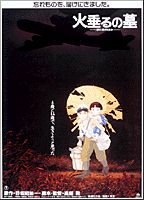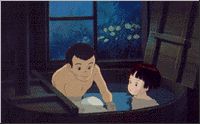| >
Articles
|
1945, In Memoriam.
|
A few months ago was celebrated the 50th anniversary
of the Japanese capitulation. Shocked by that absurd war, the
Rising Sun country has always been willing to deliver a message
of peace to the new generations. The world of manga has also been
part of this effort, especially through two of its greatest
masterpieces...
 They've been dead for already 50 years... Seita and Setsuko,
the two heroes of the melodramatic short story by Akiyuki Nosaka
Grave of the fireflies, had only asked for one thing: being
able to survive without losing their honor and their independence...
Nosaka wrote that acclaimed and award-winning moving story at the
end of the 60's, inspiring from his own tragic history. Isao Takahata, one
of the most influent people in the Ghibli studios with Hayao Miyasaki,
decided to direct an animated adaptation: a 90mn movie released in
1988, Hotaru no haka.
They've been dead for already 50 years... Seita and Setsuko,
the two heroes of the melodramatic short story by Akiyuki Nosaka
Grave of the fireflies, had only asked for one thing: being
able to survive without losing their honor and their independence...
Nosaka wrote that acclaimed and award-winning moving story at the
end of the 60's, inspiring from his own tragic history. Isao Takahata, one
of the most influent people in the Ghibli studios with Hayao Miyasaki,
decided to direct an animated adaptation: a 90mn movie released in
1988, Hotaru no haka.
Central Park Media, the famous US publisher, had the --excellent-- idea
to release it in the States in a subtitled version. Together with showings
in several cons, it allowed the French fans to discover that masterpiece
full of pain and emotion.
 1945. Seita, 14, has to face the hard truth:
because of a bombing from the Allies, he has lost his mother and must
take care alone, his father giving no sign of life, of his young sister
Setsuko (4), a cute little girl who doesn't understand very well what's
happening around her -- and it's probably better like that.
1945. Seita, 14, has to face the hard truth:
because of a bombing from the Allies, he has lost his mother and must
take care alone, his father giving no sign of life, of his young sister
Setsuko (4), a cute little girl who doesn't understand very well what's
happening around her -- and it's probably better like that.
As they were taken in by a distant cousin, they prefer to settle alone,
in an abandoned shelter near a small lake, rather than having to endure
all day long the disparaging remarks from an ultra-patriotic family.
Hunger and disease will slowly weaken them. The most terrible in
that tragedy is to imagine that the destiny of such nice, innocent
children is inexorably locked by a merciless war. Takahara has
deliberately emphasized the charm of Setsuko, just to make us
cry at the end of the movie when she dies... And the splendid music
by Michio Mamiya makes it still sadder...
Among the various examples of manga that denounce the atrocity
of war, we can mention a recent short story drawn by Tsukasa
Hôjô,the author of City hunter, which shows the
love of a young girl for a future kamikazé. It was recently published
as a paperback named Shounen-tachi no ita natsu. But among all those comics, the most paradoxical
by its mixing between life and death, are the works from Keiji Nakazawa.
He has also turned his youth into stories, through several mangas of which
awkward drawing doesn't tell against the spirit. Kuroi amé
ni utareté (Under the black rain) and Hadashi no Gen
(Barefoot Gen) have both been adapted as animation movies.
The first one, in 1984, benefited from a soundtrack by Kitarô (Queen Millenia, Silk Road),
whereas the other one was awarded the Ohfuji prize in 1983 and was given a continuation in 1986. Streamline
Pictures and Orion released the first movie in the USA, and it's WARMLY recommended.
The Hadashi no Gen manga was translated into French and published
by Albin-Michel, under the title Mourir pour le Japon (To die for Japan).
We can follow the daily life of Gen Nakaoka (i.e. Keiji Nakazawa) in Hiroshima,
with his family, who must face humiliation and pain, but also all the happiness
that a child can experiment. We discover the hard and severe life in Japanese
big cities, described in its very details. With the famous bomb exploding at the end
of the French edition (the second part is available in English),
Nakazawa showed us how that even could blow up the life of thousands
of people, quickly annihilating all their daily happiness and disagreements.
 At the moment when neo-nazis are too often on the front page (especially
on the Net), people are probably forgetting that, as long as there will be someone
to remind us of our past mistakes, especially trough such popular
supports as manga or animation cinema, we will keep inside us that
awareness which will lead us toward the hope of complete and
eternal Peace. Gen survived the bomb, Seita and his sister died
from starvation, but their destinies crossed each other, as they
shared together their hatred for war. Today, we pray with them and for them.
Shall we never forget.
At the moment when neo-nazis are too often on the front page (especially
on the Net), people are probably forgetting that, as long as there will be someone
to remind us of our past mistakes, especially trough such popular
supports as manga or animation cinema, we will keep inside us that
awareness which will lead us toward the hope of complete and
eternal Peace. Gen survived the bomb, Seita and his sister died
from starvation, but their destinies crossed each other, as they
shared together their hatred for war. Today, we pray with them and for them.
Shall we never forget.
Pictures used are from Hotaru no haka, and taken from Ghibli's site.

 Cyber Namida was created and designed by
René-Gilles Deberdt.
All rights reserved.
Cyber Namida was created and designed by
René-Gilles Deberdt.
All rights reserved.
 They've been dead for already 50 years... Seita and Setsuko,
the two heroes of the melodramatic short story by Akiyuki Nosaka
Grave of the fireflies, had only asked for one thing: being
able to survive without losing their honor and their independence...
Nosaka wrote that acclaimed and award-winning moving story at the
end of the 60's, inspiring from his own tragic history. Isao Takahata, one
of the most influent people in the Ghibli studios with Hayao Miyasaki,
decided to direct an animated adaptation: a 90mn movie released in
1988, Hotaru no haka.
They've been dead for already 50 years... Seita and Setsuko,
the two heroes of the melodramatic short story by Akiyuki Nosaka
Grave of the fireflies, had only asked for one thing: being
able to survive without losing their honor and their independence...
Nosaka wrote that acclaimed and award-winning moving story at the
end of the 60's, inspiring from his own tragic history. Isao Takahata, one
of the most influent people in the Ghibli studios with Hayao Miyasaki,
decided to direct an animated adaptation: a 90mn movie released in
1988, Hotaru no haka.
 1945. Seita, 14, has to face the hard truth:
because of a bombing from the Allies, he has lost his mother and must
take care alone, his father giving no sign of life, of his young sister
Setsuko (4), a cute little girl who doesn't understand very well what's
happening around her -- and it's probably better like that.
1945. Seita, 14, has to face the hard truth:
because of a bombing from the Allies, he has lost his mother and must
take care alone, his father giving no sign of life, of his young sister
Setsuko (4), a cute little girl who doesn't understand very well what's
happening around her -- and it's probably better like that.
 At the moment when neo-nazis are too often on the front page (especially
on the Net), people are probably forgetting that, as long as there will be someone
to remind us of our past mistakes, especially trough such popular
supports as manga or animation cinema, we will keep inside us that
awareness which will lead us toward the hope of complete and
eternal Peace. Gen survived the bomb, Seita and his sister died
from starvation, but their destinies crossed each other, as they
shared together their hatred for war. Today, we pray with them and for them.
Shall we never forget.
At the moment when neo-nazis are too often on the front page (especially
on the Net), people are probably forgetting that, as long as there will be someone
to remind us of our past mistakes, especially trough such popular
supports as manga or animation cinema, we will keep inside us that
awareness which will lead us toward the hope of complete and
eternal Peace. Gen survived the bomb, Seita and his sister died
from starvation, but their destinies crossed each other, as they
shared together their hatred for war. Today, we pray with them and for them.
Shall we never forget.